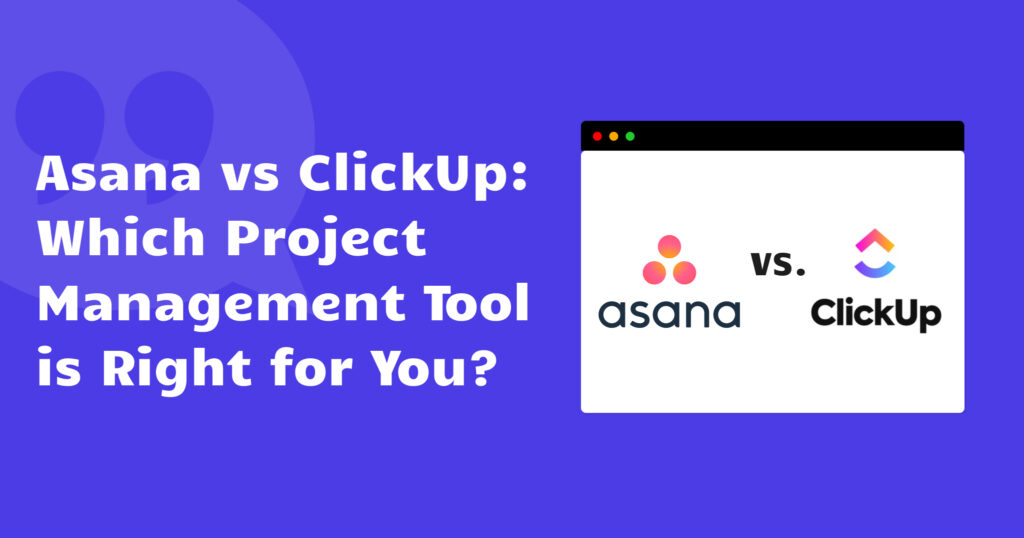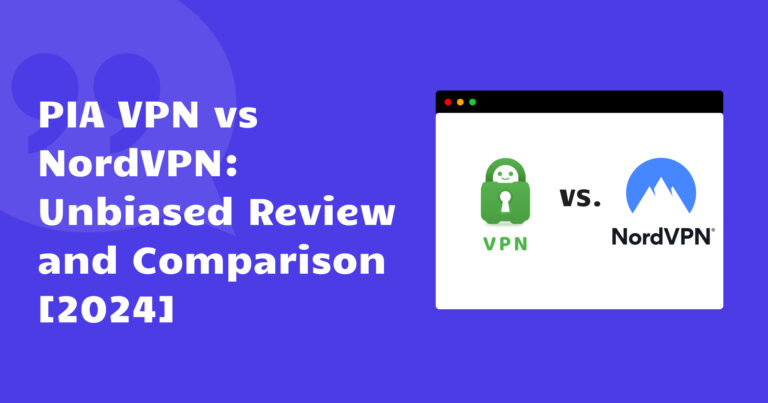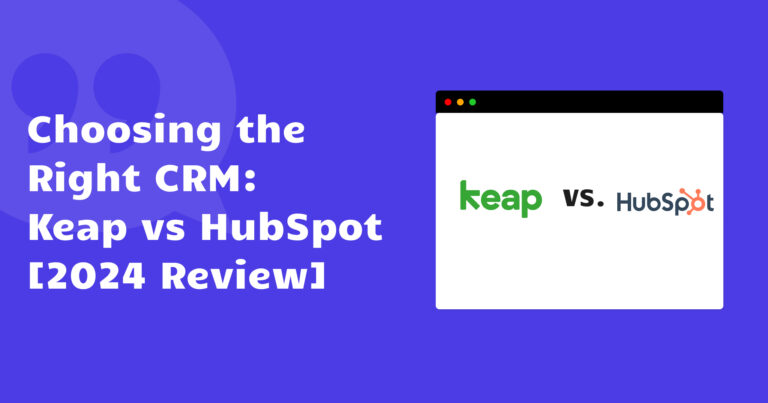Choosing the right project management tool can make all the difference in optimizing workflows and ensuring successful project execution. Asana and ClickUp stand out as two prominent contenders, each offering a robust set of features designed to streamline tasks and enhance collaboration.
We’ll dive together into the strengths and weaknesses of both platforms, helping you make an informed decision on which project management tool aligns best with your team’s needs and goals.
So let’s get started! 💪
Table of contents
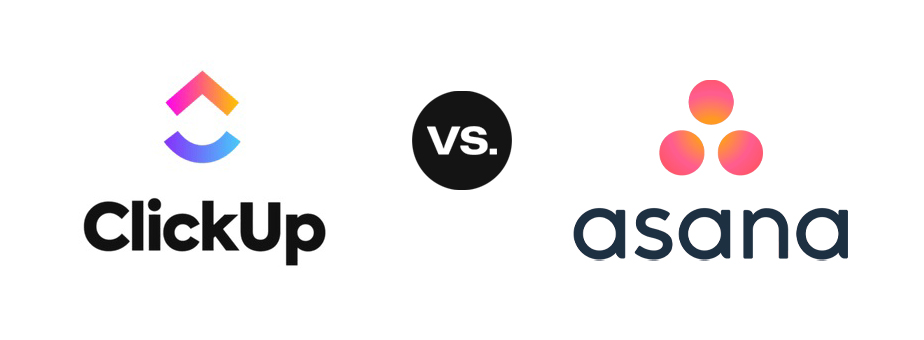
Asana, known for its user-friendly interface and versatile task management capabilities, has become a go-to choice for teams ranging from startups to enterprise-level corporations.
On the other hand, ClickUp positions itself as an all-in-one project management software, showing off a wide array of features that span task management, document collaboration, time tracking, and more.
If you are in a hurry, here are some key points to keep in mind when deciding if ClickUp or Asana is the right project management solution for your team:
| Feature | Asana | ClickUp |
| Task Management | Simple lists, boards, calendar view | Flexible lists,boards, calendars, mind maps, Gantt charts, Kanban boards |
| Collaboration | Task comments, @mentions, file sharing, basic team discussions | Advanced comments, @mentions, docs (internal wiki), chat, goals (shared objectives), pulse (team updates) |
| Organization | Projects, subtasks, tags, custom fields (limited) | Projects, spaces (nested projects), folders, lists, checklists, tags, custom fields (extensive), goals |
| Automation & integrations | Rules (basic automations), limited integrations | Automations (powerful and customizable), Zapier and 1000+ integrations |
| Reporting & analytics | Basic project and portfolio reports | Detailed reports on time, track progress, workload, custom metrics |
| Time tracking | Not included | Built-in global time tracker |
| Security & access control | Multi-factor authentication, team permissions | Single sign-on, role-based permissions, guest access |
| Pricing | Free plan for individuals, tiered paid plans | Free plan with generous features, tiered paid plans |
Navigating the Project Management Landscape
Before we dive into the nitty-gritty details, let’s set the stage by understanding what makes Asana and ClickUp so unique and what they bring to the table.
⚙️ User-Friendly Elegance of Asana:
Asana has earned its badge for its simplicity and user-friendly interface. Its design prioritizes intuitive task management tools, making it accessible for teams of all sizes.
Whether you’re a startup with a handful of members or a large enterprise, Asana’s clean layout encourages quick adoption and seamless integration into existing workflows. The platform’s task-centric approach provides clarity, allowing teams to focus on what needs to be done without getting lost in a maze of features.
⚙️ ClickUp’s All-Encompassing Approach:
Contrasting with Asana’s focused simplicity, ClickUp embraces an all-encompassing philosophy. It positions itself as not just a project management platform but a comprehensive productivity tool.
This holistic approach means that ClickUp caters to a spectrum of organizational needs beyond task tracking, including document collaboration, goal setting, and time tracking. For teams seeking a unified solution that eliminates the need for juggling multiple tools, ClickUp’s extensive feature set can be a compelling proposition.
⚙️ Adapting to Varied Workflows:
Understanding the unique dynamics of your team’s workflow is essential in choosing the right work management platform.
Asana’s straightforward approach may be particularly appealing for teams with straightforward processes and a preference for simplicity.
On the other hand, ClickUp’s adaptability shines in environments where workflows are diverse and complex, offering customization options to tailor the platform to the specific needs of different teams within an organization.
⚙️ Flexibility and Scalability:
The scalability of a project management tool is a pivotal consideration, especially for growing organizations.
Asana’s straightforward design lends itself well to scalability, making it a popular choice for teams experiencing rapid expansion.
ClickUp, with its versatility and all-in-one approach, is designed to scale seamlessly, accommodating the evolving needs of both small teams and large enterprises.
⚙️ Balancing Features and Usability:
While features are undeniably crucial, striking the right balance between functionality and usability is key.
Asana’s minimalist approach ensures that teams can quickly grasp its functionalities, fostering faster adoption.
ClickUp’s challenge lies in managing its vast feature set without overwhelming users.
However, for those willing to invest time in mastering its capabilities, the payoff in terms of comprehensive project management can be substantial.
Pros and Cons
Each project management tool brings a unique set of strengths to the table, addressing specific needs and preferences.
So, let’s explore both tools:
🟢 Asana
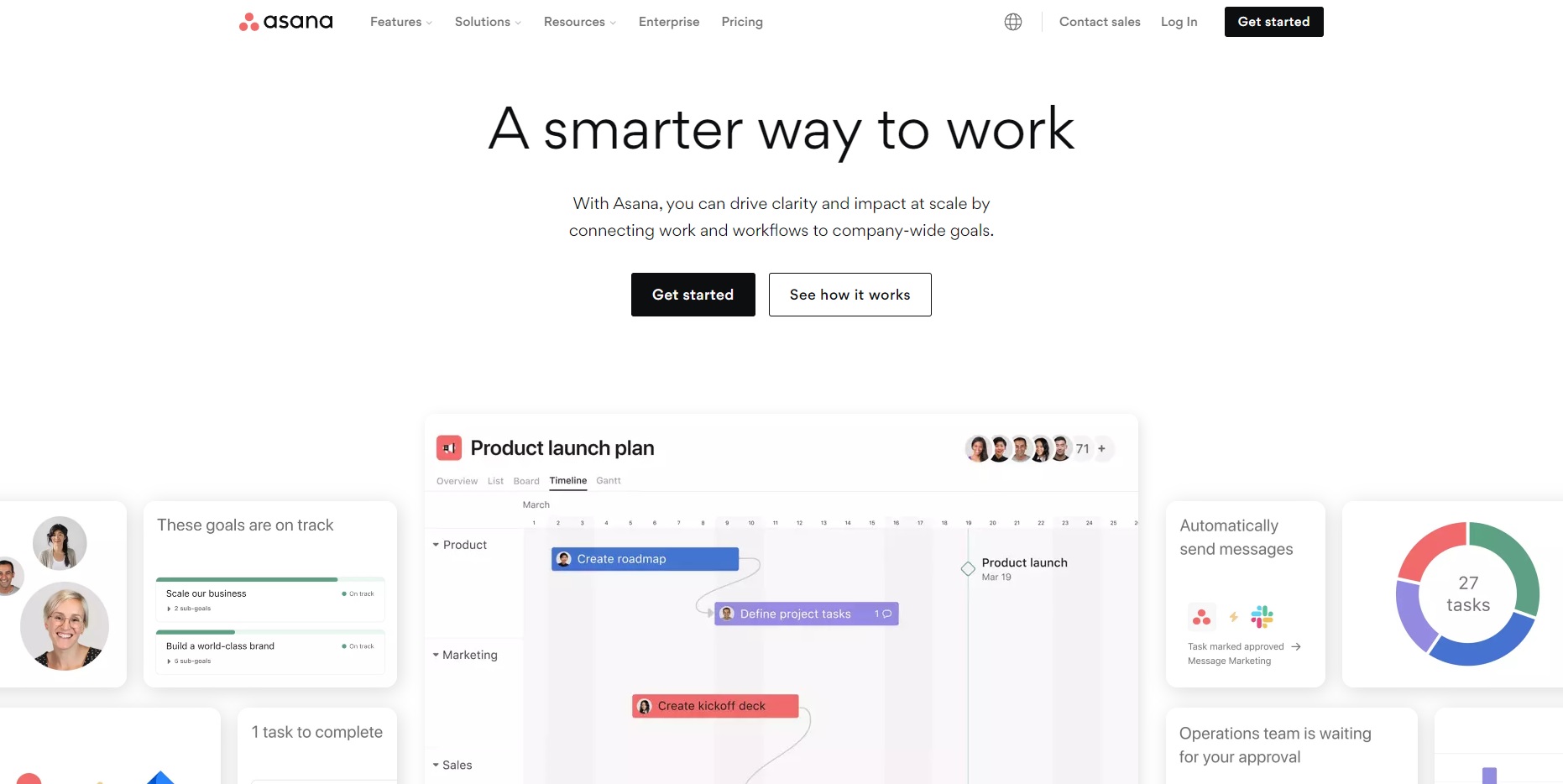
| Pros | Cons |
| Simple and intuitive interface: Easy to learn and use, even for non-technical users. | Limited customization: Fewer features and less flexibility compared to ClickUp. |
| Focus on clarity and task management: Streamlined workflow for basic project organization. | No built-in time tracking: Requires integrations for time management. |
| Strong emphasis on team communication: Solid commenting and @mention features. | Weaker collaboration tools: Less advanced features for team discussions and shared documents. |
| Robust mobile app: Excellent experience on smartphones and tablets. | Higher pricing for larger teams: Paid plans can get expensive for many users. |
🟢 ClickUp
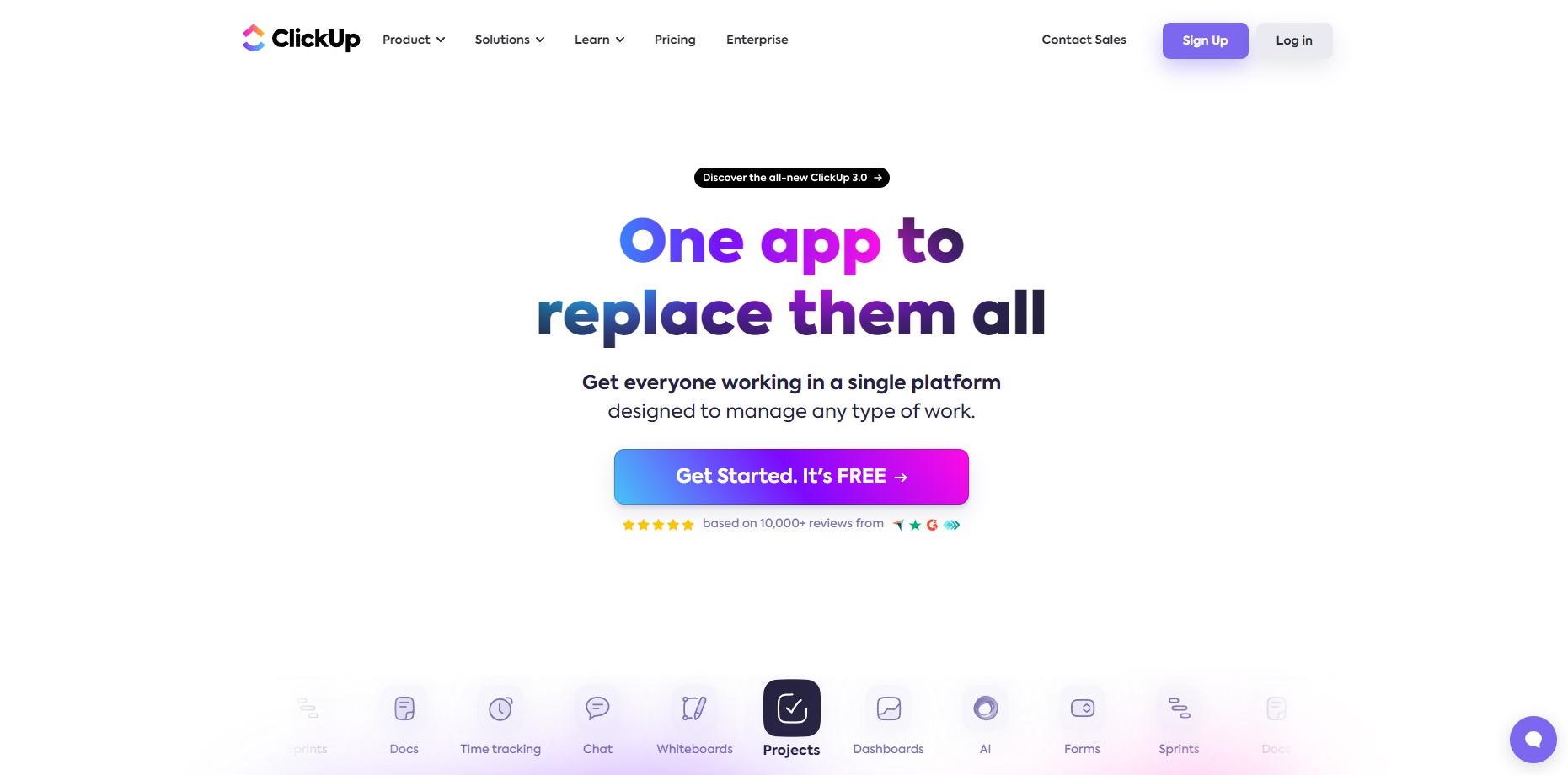
| Pros | Cons |
| Highly customizable: Flexible platform with a wide range of features and views. | Steeper learning curve: More complex interface than Asana, requires some time to master. |
| Powerful automation and integrations: Extensive capabilities for automating workflows and connecting with other tools. | Can be overwhelming: Feature-richness can feel like overkill for simpler projects. |
| Advanced collaboration tools: Built-in Docs, Chat, Goals, and Pulse features for better team collaboration and engagement. | Time tracking limited in free plan: Paid plans needed for full time tracking functionality. |
| Generous free plan: Many features available for free, making it a budget-friendly option for small teams. | Mobile app not as polished as Asana: Mobile experience could be improved. |
Pricing Structure
The pricing structures of Asana and ClickUp play a pivotal role in determining the feasibility and scalability of these platforms for your team.
Here’s what both tools offer in terms of pricing:
Asana
Asana offers a freemium model with a basic free plan and premium plans starting at a per-user monthly fee. The premium plans unlock advanced features like Timeline, reporting, and additional customization options.
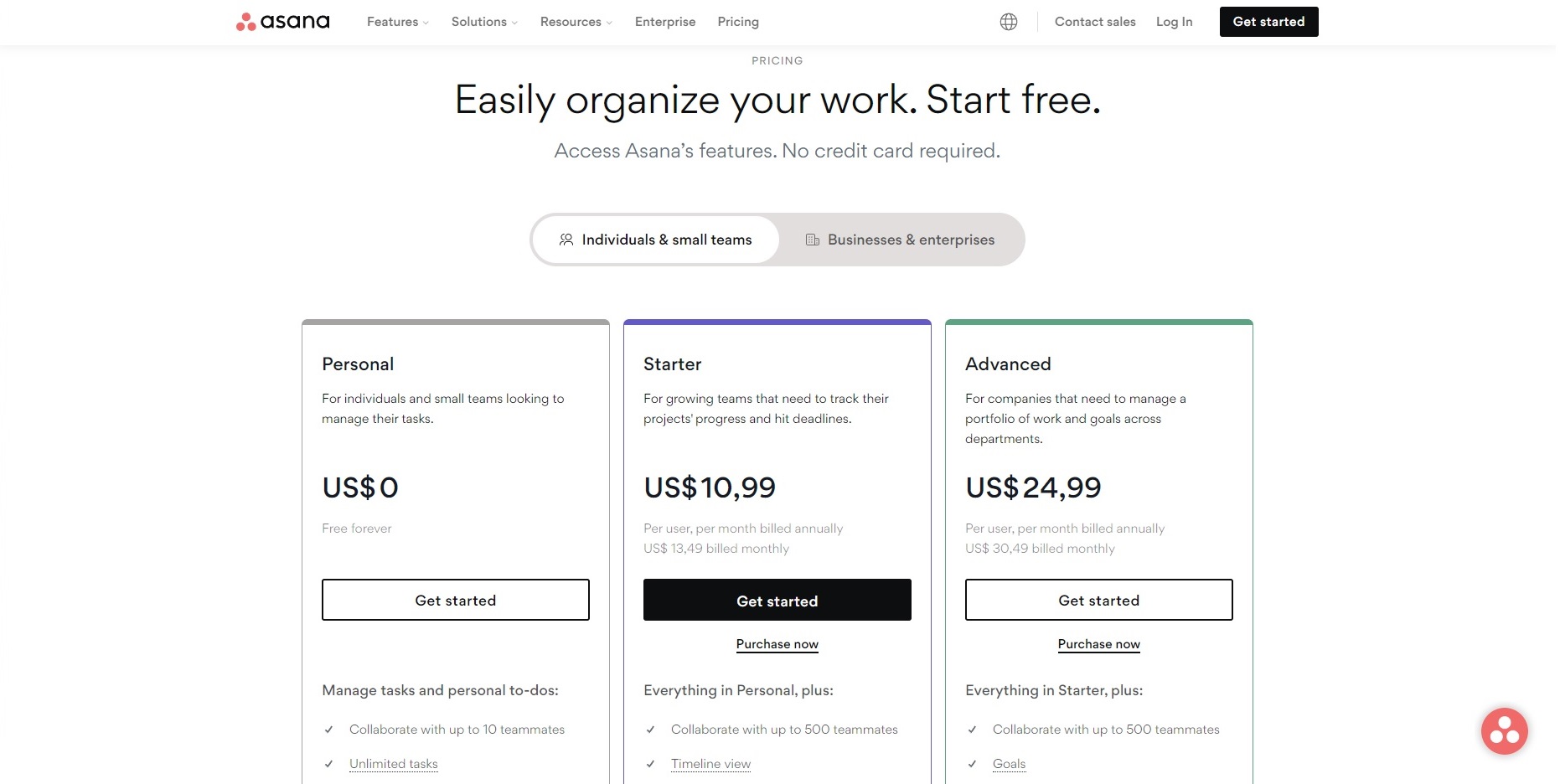
The best Asana plan for your team depends on your specific needs and budget. If you’re just starting out, the Free plan is a great way to test the waters.
Asana’s Free plan key features:
- Collaborate with up to 10 team members.
- Unlimited: tasks, projects, messages, activity log, file storage (100MB per file), assignee and due dates.
- Projects: list view, board view, calendar view.
- Basic search filters, status updates, mobile app, time tracking with integrations, 100+ free extra integrations
The Free plan sounds already great if you have a small team of up to 10 people.
The Starter and Advanced plans are for companies with up to 500 teammates. Keep in mind that the price on both of these plans are per individual.
As your team grows, you can upgrade to a paid plan for more features and functionality. 😊
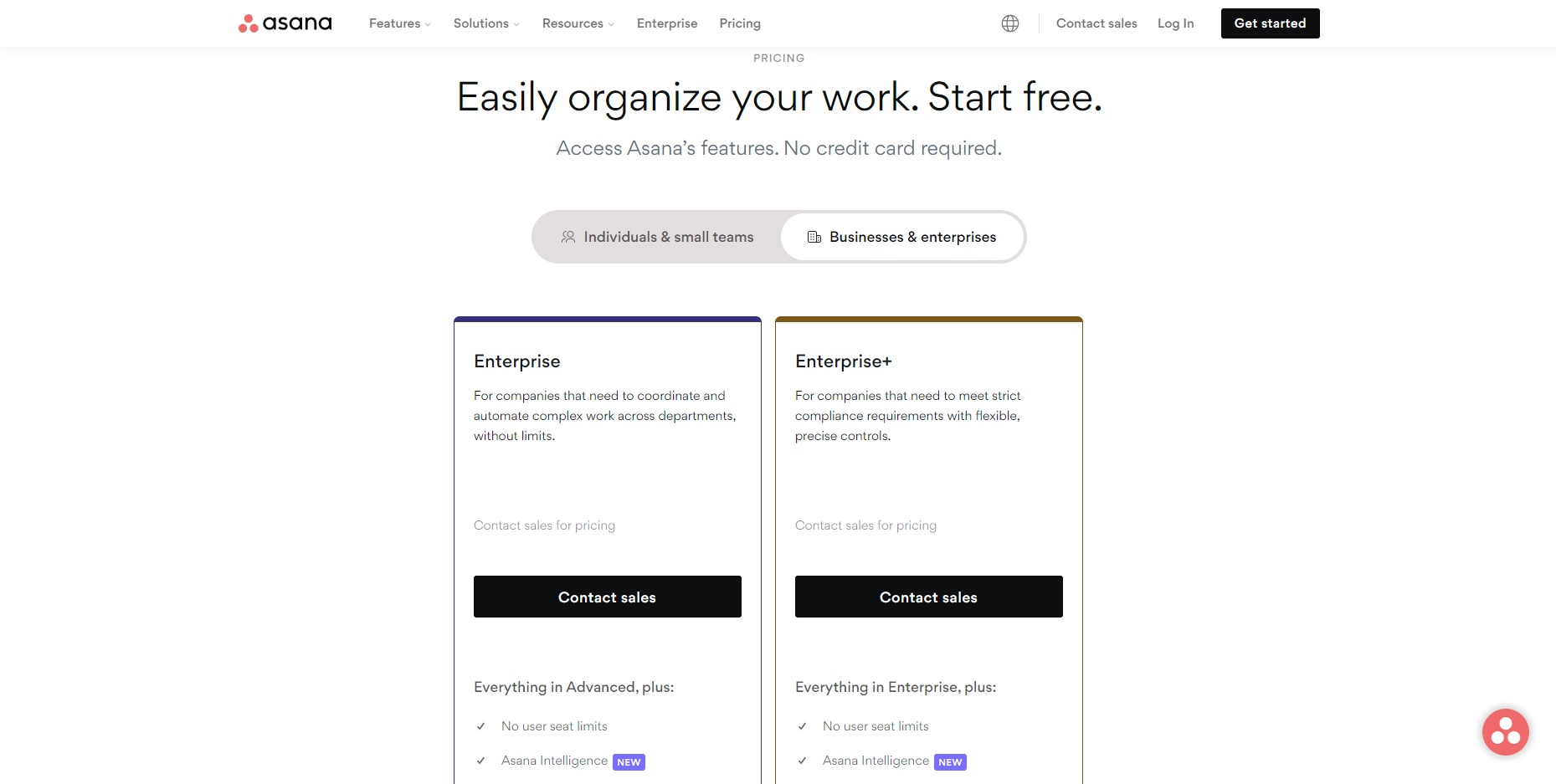
The Enterprise and Enterprise+ plans are for companies that need to coordinate and automate complex work across departments, without limits as well as companies that need to meet strict compliance requirements with flexible, precise controls. Here you need to contact them for a custom offer.
ClickUp
ClickUp provides a free plan and multiple premium plans, including an Unlimited plan for larger teams. The pricing is tiered based on the number of users and billed monthly or annually.

The Free Forever plan provides essential features for small teams, while the Unlimited plan caters to larger organizations with advanced needs.
The pricing is both flexible and scalable, allowing users to opt for monthly or annual billing.
Clickup’s Free plan key features:
- 100MB storage
- Unlimited: tasks, free plan members
- Two-Factor Authentication
- Collaborative Docs, whiteboards, real-time chat, calendar view
- Everything view, Kanban boards,
- Sprint management
- Custom field manager (basic)
The free plan is perfect for personal use and small, casual teams. It’s ideal for simple tasks and light collaboration.
As your needs grow, consider the Unlimited plan for most, the Business plan for mid-sized teams with stricter access control, and the Business Plus or Enterprise plans for complex workflow automation and large-scale operations.
Clickup’s pricing page shows a very detailed side-by-side comparison of what each of these plans offer.
Considerations for Your Budget
When evaluating the pricing structures, consider not only your current budget but also the scalability of your chosen tool.
Asana’s clear per-user pricing may be preferable for smaller teams with stable resource requirements.
In contrast, ClickUp’s tiered structure allows organizations to adapt their investment to their current needs while anticipating future growth.
Assessing the value each platform provides within your budgetary constraints ensures that your project management tool not only meets your immediate needs but also aligns with your financial objectives in the long run.
Factors to Consider: Which one is the best for your team?
Choosing the right project management tool involves a thoughtful evaluation of factors that go beyond features and pricing.
✅ Team Size and Structure:
Consider the size and structure of your team. Asana’s simplicity makes it well-suited for smaller teams, fostering quick adoption and streamlined collaboration. On the other hand, ClickUp’s extensive features cater to larger teams with diverse roles and responsibilities, providing a comprehensive solution for complex project ecosystems.
✅ Budget Constraints:
Evaluate your budget constraints against the features offered in each platform’s free and premium plans. Asana’s clear per-user pricing may align well with smaller budgets, while ClickUp’s tiered structure offers flexibility for both startups and enterprises.
✅ Learning Curve:
Assess your team’s adaptability to new tools. Asana’s user-friendly interface makes it an ideal choice for teams that prioritize quick onboarding. ClickUp, with its extensive feature set, may require a steeper learning curve, but the investment in time can unlock a powerful array of project management capabilities.
✅ Project Complexity:
The nature of your projects plays a significant role in your choice. Asana’s simplicity is effective for straightforward task management, while ClickUp’s versatility shines in handling intricate projects with diverse requirements. Consider the complexity of your projects and the adaptability your chosen tool offers.
✅ Integration with Existing Tools:
Evaluate how seamlessly each platform integrates with your existing suite of tools. Asana’s integration capabilities with various third-party apps enhance its functionality, while ClickUp’s all-in-one approach may reduce the need for multiple integrations but requires careful consideration of existing workflows.
✅ Collaboration and Communication Needs:
Assess your team’s collaboration and communication needs. Asana’s task-centric design with features like comments and mentions fosters direct collaboration within tasks. ClickUp’s extensive built in collaboration tools, including document collaboration and built-in chat, may be more suitable for teams with diverse communication requirements.
✅ Long-Term Scalability:
Consider the long-term scalability of your chosen tool. As your team grows, the scalability of Asana and ClickUp becomes crucial. Asana’s simplicity ensures easy scalability, while ClickUp’s versatility accommodates the evolving needs of both small and large teams.
Tip: You can play a key role by suggesting these options to your team. Let them explore both choices and decide which one suits them best. 😉
In navigating these considerations, it’s vital to weigh each factor based on your team’s unique dynamics and project management goals. By carefully assessing these aspects, you can confidently select the project management tool that not only meets your immediate needs but also aligns seamlessly with your team’s future endeavors.
Wrapping up…
Standing at the crossroads of Asana vs Clickup, the decision between these two project management tools may seem like a daunting task.
While both platforms provide impressive features and boast dedicated user communities, the optimal choice depends on how well it aligns with your team’s specific needs and workflow.
For teams valuing simplicity and straightforward task management, Asana serves as a reliable choice. With its intuitive interface, focus on task organization, and a robust mobile app, it facilitates efficient execution and collaboration.
On the other hand, if your team seeks a plethora of features and the flexibility to tailor workflows, ClickUp presents itself as a versatile option. Offering extensive customization, powerful automation, and a wide array of integrations, it empowers teams to design workflows that resonate with their unique dynamics.
It’s important to note that this isn’t a winner-takes-all scenario. Both ClickUp and Asana provide generous free plans and trial periods. Utilize these opportunities to experiment, gather team feedback, and determine which tool sparks your project management enthusiasm.
May your tasks flow smoothly, your deadlines be met, and your collaboration be harmonious. 💪

